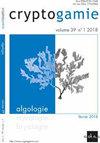Morphology and Ecology of a New Centric Diatom Belonging to the Cyclotella comta (Ehrenberg) Kützing Complex: Lindavia khinganensis sp. nov. from the Greater Khingan Range, Northeastern China
IF 1.5
4区 生物学
Q3 MARINE & FRESHWATER BIOLOGY
引用次数: 8
Abstract
Abstract During an investigation on the diatom communities of volcanic lakes of Northeastern China a new species belonging to the “Cyclotella comta species complex” was observed. This taxon forms relatively large populations in the phytoplankton of Lake Tuofengling Tianchi, a 33m-deep, oligotrophic, crater lake located in Inner Mongolia. In this paper, the valve morphology and ultrastructure of this taxon is described using light and scanning electron microscopy and a new name, Lindavia khinganensis sp. nov., is proposed. A discriminant analysis based on morphological LM and SEM data confirmed that L. khinganensis is distinct from other Lindavia species with a similar morphology such as L. comta (Ehrenberg) Nakov et al., L. radiosa (Grunow) De Toni & Forti, L. balatonis (Pantocsek) Nakov et al., L. praetermissa (Lund) Nakov et al. and L. tenuistriata (Hustedt) Nakov et al. In addition, the seasonal and interannual distribution of L. khinganensis was investigated using sediment trap samples collected over a two-year period. Limnological data from Lake Tuofengling, including water chemistry and temperature recording from a thermistor chain provided complementary information about the ecology of this new species. This species was not found in any other lakes from Northeastern China that we investigated.属于Cyclotella comta (Ehrenberg) k tzing复合体的一种新中心硅藻的形态和生态学:大兴安岭Lindavia khinganensis sp. nov.
摘要在对东北火山湖硅藻群落的调查中,发现了一种属于“Cyclotella comta种群”的新种。该分类群在内蒙古托峰岭天池湖浮游植物中形成了相对较大的种群。托峰岭天池湖是一个深33米的贫营养火山口湖。本文利用光镜和扫描电镜对该分类群的阀瓣形态和超微结构进行了描述,并提出了一个新名称linddavia khinganensis sp. nov.。基于形态学LM和SEM数据的判别分析证实,L. khinganensis不同于L. comta (Ehrenberg) Nakov等人、L. radiosa (Grunow) De Toni & Forti、L. balatonis (Pantocsek) Nakov等人、L. praetermissa (Lund) Nakov等人以及L. tenuistriata (Hustedt) Nakov等人等形态相似的林达属植物。此外,利用沉积物诱捕器采集了2年的样品,研究了兴安草的季节和年际分布。沱峰岭湖的湖泊数据,包括水化学和热敏电阻链的温度记录,为该新种的生态学提供了补充信息。本种在我们调查的东北其他湖泊中均未发现。
本文章由计算机程序翻译,如有差异,请以英文原文为准。
求助全文
约1分钟内获得全文
求助全文
来源期刊

Cryptogamie Algologie
生物-海洋与淡水生物学
CiteScore
2.60
自引率
7.70%
发文量
11
审稿时长
>12 weeks
期刊介绍:
Cryptogamie is a fast-track and peer-reviewed journal of international scope publishing in English only. It accepts original papers and review articles on the taxonomy, biology and ecology of all cryptogams. An issue of Cryptogamie may be devoted to a single topic, under the responsibility of guest editor(s). All articles published in Cryptogamie are compliant with the different nomenclatural codes. A copyright assignment will be signed by the authors before publication.
Cryptogamie, Algologie accepts articles on systematics as well as ecology and evolution of any kind of algae (including Cyanobacteria).
 求助内容:
求助内容: 应助结果提醒方式:
应助结果提醒方式:


